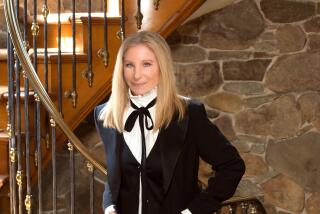BOOK REVIEW / BIOGRAPHY : Skimming Only the Surface of the Real Barbara Stanwyck : STANWYCK <i> by Axel Madsen</i> ; HarperCollins $25, 432 pages
- Share via
How do I like Barbara Stanwyck? Let me count the ways: She confirmed that short women (5 feet, 3 inches) could be regal and sexy and formidable. She could say more walking slowly down a staircase (“Double Indemnity”) or putting on a shoe (“The Lady Eve”) than most actresses could in a five-page monologue. She managed somehow to be tough and brassy as well as sensitive and expressive; too many stars stick with one or the other. And she invented herself, turning the orphaned Ruby Stevens into a nonstop actress whose one flaw, perhaps, was her inability to stop long enough to catch her breath.
I wish I liked Axel Madsen’s biography, “Stanwyck,” as well. He certainly wins the prize for dogged pursuit of a reluctant subject. Madsen met Stanwyck during her “The Big Valley” days and had several interviews with her. Stanwyck, however, was known for pulling punches when it came to self-disclosure, and unfortunately (for the reader, at least), she was better at what she did than was any writer who approached her. Stanwyck simply did not like to talk, whether because she thought her private life was nobody’s business or (as the author implies) because she had suffered such pain in her early life that it hurt too much to talk about subsequent difficulties.
So Madsen does what I suppose anyone in his position would do, though it makes me uncomfortable: He builds bridges between information and hypothesis, based on speculation, coincidence and social trends. Although some of his conclusions may be true, nobody’s talking--or they are, and they contradict each other. The result too often feels like conjecture, like prying. It’s an interesting moral question: If Barbara Stanwyck worked so hard to protect her private life, and if circumstantial evidence is just that, then what right does the writer have to insinuate?
Take the issue of Stanwyck’s sexual orientation. Madsen says she is an icon among lesbians because of her uncompromising independence, her unwillingness to use sex to manipulate men. (Did any of the people he’s referring to see “The Lady Eve,” or was that bit of seduction conveniently forgotten in the formation of the thesis?) She never conceived a child, though she and her first husband adopted a son. Her first husband drank; her second, Robert Taylor, was the target of rumors about his sexual orientation. She had a lifelong friendship (though there is no evidence it was consummated physically) with her public relations protector, Helen Ferguson. And there was a gay subculture in Hollywood when she was there.
Madsen carefully avoids asserting that Stanwyck was gay; instead he loads up the evidence, tosses in the occasional disclaiming sentence, and seems to hope the reader will draw the kind of conclusions that sell celebrity biographies.
Because Madsen worked without the extensive cooperation of his subject, his book is full of compensatory information. We get list upon list of where Stanwyck went, and with whom, of how she handled this director and that one. The author seems to be captivated by detail, but unable to shape it into the kind of narrative that Stanwyck deserves. Her life had a remarkable arc to it; the book, sadly, often seems stalled in neutral.
There are plenty of factoids, heaven knows, most of them having to do with romances, real or rumored, few of them as conclusive as one might like. Director Frank Capra either was Stanwyck’s lover or he wasn’t, depending on whether you believe his own memoir or other evidence Madsen has unearthed. Die-hard Stanwyck fans may choose to read “Stanwyck,” because any information is better than none, and because Madsen seems to have read everything ever written about her or anyone who knew her; if there’s a tidbit outstanding, it’s hard to imagine what it is.
But it’s almost impossible to read the book without conjuring an image of Stanwyck, a wry smile on her face, a bemused, smug air about her. She had the last laugh, as she always intended. The truth about her--the philosophical truth that would have lent substance to the surface details--is missing. She took it with her, as intended, to the grave. Not many celebrities manage to look after themselves so well.
More to Read
Sign up for our Book Club newsletter
Get the latest news, events and more from the Los Angeles Times Book Club, and help us get L.A. reading and talking.
You may occasionally receive promotional content from the Los Angeles Times.









